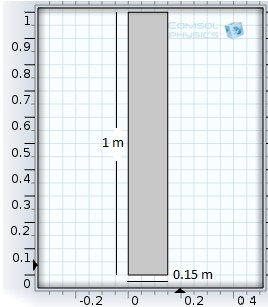Evaluación del Apantallamiento electromagnético del concreto
Evaluation of electromagnetic shielding of concrete
Barra lateral del artículo

Términos de la licencia (VER)

Esta obra está bajo una licencia internacional Creative Commons Atribución-NoComercial-SinDerivadas 4.0.
Declaración del copyright
Los autores ceden en exclusiva a la Universidad EIA, con facultad de cesión a terceros, todos los derechos de explotación que deriven de los trabajos que sean aceptados para su publicación en la Revista EIA, así como en cualquier producto derivados de la misma y, en particular, los de reproducción, distribución, comunicación pública (incluida la puesta a disposición interactiva) y transformación (incluidas la adaptación, la modificación y, en su caso, la traducción), para todas las modalidades de explotación (a título enunciativo y no limitativo: en formato papel, electrónico, on-line, soporte informático o audiovisual, así como en cualquier otro formato, incluso con finalidad promocional o publicitaria y/o para la realización de productos derivados), para un ámbito territorial mundial y para toda la duración legal de los derechos prevista en el vigente texto difundido de la Ley de Propiedad Intelectual. Esta cesión la realizarán los autores sin derecho a ningún tipo de remuneración o indemnización.
La autorización conferida a la Revista EIA estará vigente a partir de la fecha en que se incluye en el volumen y número respectivo en el Sistema Open Journal Systems de la Revista EIA, así como en las diferentes bases e índices de datos en que se encuentra indexada la publicación.
Todos los contenidos de la Revista EIA, están publicados bajo la Licencia Creative Commons Atribución-NoComercial-NoDerivativa 4.0 Internacional
Licencia
![]()
Esta obra está bajo una Licencia Creative Commons Atribución-NoComercial-NoDerivativa 4.0 Internacional
Contenido principal del artículo
Resumen
Descargas
Detalles del artículo
Camilo Granados, Grupo de Compatibilidad e Interferencia Electromagnética, Universidad Distrital Francisco José de Caldas
Ingeniero Eléctrico, Estudiante de Maestría en Ingeniería, Universidad Nacional de Colombia.Herbert Rojas, Universidad Distrital Francisco José de Caldas
Profesor Asociado. Facultad de Ingeniería. Ingeniería Eléctrica.Francisco Santamaria, Universidad Distrital Francisco José de Caldas
Profesor Asociado. Facultad de Ingeniería. Ingeniería Eléctrica. Doctorado en IngenieríaReferencias (VER)
A Shaari, Millard, S. and Bungey, J. (2002) ‘Measurement of Radar Properties of Concrete for in Situ Structural Elements’, IEEE International Conference on Ground Penetrating Radar (GPR), pp. 756–758.
Achedad, C. and Giménez, L. (2008) Ingeniería de organización: Modelos y aplicaciones. Madrid, España.
Anoop, S. et al. (2011) ‘Synthesis, charge transport studies, and microwave shielding behavior of nanocomposites of polyaniline with Ti-doped γ-Fe2O3’, Journal of Materials Science, 47(5), pp. 2461–2471.
Antonini, G., Orlandi, A. and Stefano, D. (2003) ‘Shielding Effects of Reinforced Concrete Structures to Electromagnetic Fields due to GSM and UMTS Systems’, IEEE Transactions on Magnetics. New York, USA, 39(3), pp. 1582–1585.
Askeland, D. (1998) Ciencia e Ingenieria de los Materiales. USA, New York.
Celozzi, S., Araneo, R. and Lovat, G. (1999) Electromagnetic Shielding. Italy, Roma. doi: 10.1002/047134608X.W3403.
Chahine, K. et al. (2009) ‘On the variants of Jonscher’s model for the electromagnetic characterization of concrete’, IEEE International Conference on Ground Penetrating Radar (GPR). Nantes, Francia, (9), pp. 1–6.
Choudhary, V., Dhawan, S. and Saini, P. (2012) ‘Polymer based nanocomposites for electromagnetic interference ( EMI ) shielding’, Indian Institute of Technology, 661(2).
Chung, D. (2000) ‘Materials for Electromagnetic Interference Shielding’, Materials engineering and performance, 9(5), pp. 350–354.
Colombo, J. (2012) Análisis y mediciones de los parámetros de dispersión o Scattering parameters en un cuadripolo o en una red de n puertos (multipolo). Universidad tecnológica nacional.
COMSOL (2013) Meshing Considerations for Linear Static Problems.
COMSOL Multiphysics (2013) Introduction to COMSOL Multiphysics, Version 4.3b. U.S.
Dalke, R. et al. (2000) ‘Effects of Reinforced Concrete Structures on RF Comunications’, IEEE Transactions on Electromagnetic Compatibility. New York, USA, 42(4), pp. 486–496.
Feitor, B. et al. (2011) Estimation of Dielectric Concrete Properties from Power Measurements at 18 . 7 and 60 GHz. Leiria, Portugal.
Galao, O. (2012) Matrices cementicias multifuncionales mediante adición de nanofibras de carbono. Universidad de Alicante.
Guan, H. et al. (2006) ‘Cement based electromagnetic shielding and absorbing building materials’, Cement and Concrete Composites, 28(5), pp. 468–474. doi: 10.1016/j.cemconcomp.2005.12.004.
Guzman, G. (1992) Verificación de efectividad de blindaje electromagnético por teorema se reciprocidad. Universidad Autónoma de Nuevo León.
Hemming, L. (1992) Architectural Electromagnetic Shielding Handbook. USA, New York: IEEE The institute of Electrical and Engineer.
Hernández, J. (1999) Teoría de líneas de trasmisión e ingeniería de microondas. Mexicali, México.
Ihamouten, A. et al. (2011) ‘On Variants of the Frequency Power Law for the Electromagnetic Characterization of Hydraulic Concrete’, 60(11), pp. 3658–3668.
International Electrotechnical Commission IEC (2000) International standard IEC 61000 1-1, Electromagnetic compatibility (EMC) - Part 1-1: General - Application and interpretation of fundamental definitions and terms. Suiza.
Jonscher, A. (1990a) ‘The “Universal” Dielectric Reponse: Part I’, IEEE Electrical Insulation Magazine, 6(2), pp. 16–22.
Jonscher, A. (1990) ‘The “Universal” Dielectric Reponse: Part II’, IEEE Electrical Insulation Magazine, 6(3), pp. 24–28.
Jonscher, A. (1990b) ‘The “Universal” Dielectric Reponse: Part III’, IEEE Electrical Insulation Magazine, 6(4), pp. 19–24.
Kaur, M., Kakar, S. and Mandal, D. (2011) ‘Electromagnetic interference’, IEEE International Conference on Electronics Computer Technology (ICECT). Punjab, India: IEEE, 4, pp. 1–5.
Keshtkar, A., Maghoul, A. and Kalantarnia, A. (2010) ‘Investigation of Shielding Effectiveness Caused by Incident Plane Wave on Conductive Enclosure in UHF Band’, IEEE International Conference on Mechanical and Aerospace Engineering. Tabriz, Iran, 110, pp. 485–490.
Kim, H. et al. (2004) ‘Electrical conductivity and electromagnetic interference shielding of multiwalled carbon nanotube composites containing Fe catalyst’, Applied Physics Letters, 84(4), p. 589.
Laurens, S. et al. (2003) ‘Non destructive evaluation of concrete moisture by GPR technique: experimental study and direct modeling’, Materials and Structures, 38(9), pp. 827–832.
Ogunsola, A., Reggiani, U. and Sandrolini, L. (2005) ‘Shielding effectiveness of concrete buildings’, IEEE International Symposium Electromagnetic Compatibility and Electromagnetic Ecology, pp. 65–68.
Ogunsola, A., Reggiani, U. and Sandrolini, L. (2006) ‘Modelling shielding properties of concrete’, IEEE International Zurich Symposium on Electromagnetic Compatibility. Londres, Inglaterra, pp. 34–37.
Ogunsola, A., Reggiani, U. and Sandrolini, L. (2009) ‘Shielding properties of conductive concrete against transient electromagnetic disturbances’, IEEE International Conference on Microwaves, Communications, Antennas and Electronics Systems. Bologna, Italia, 1, pp. 1–5. doi: 10.1109/COMCAS.2009.5385975.
Pokkuluri, K. (1998) Effect of Admixtures , Chlorides , and Moisture on Dielectric Properties of Portland Cement Concrete in the Low Microwave Frequency Range. Ph.D. dissertation, Civil Eng. Dept.,Virginia Polytechnic Institute and State University.
R. Haddad and Al-Qadi, I. (1998) ‘Characterization of portland cement concrete using electromagnetic waves over the microwave frequencies’, Elsevier Science Ltd, 28(10), pp. 1379–1391.
Render, B. (2004) Principios de administración de operaciones. Seguin, USA.
Rhim, H. and Buyukozturk, O. (1998) ‘Electromagnetic Properties of Concrete at Microwave Frequency Range’, ACI Materials, 95(3), pp. 262–271.
Robert, A. (1998) ‘Dielectric permittivity of concrete between 50 Mhz and 1 Ghz and GPR measurements for building materials evaluation’, Journal of Applied Geophysics. Montreal, Canadá, 40(1–3), pp. 89–94.
Romanca, M. et al. (2008) ‘Methods of Investigating Construction Materials used for Intelligent Building Shielding’, IEEE International Conference on Optimization of Electrical and Electronic Equipment. Braşov, Romania, 1, pp. 191–196.
Saini, P. et al. (2009) ‘Polyaniline–MWCNT nanocomposites for microwave absorption and EMI shielding’, Materials Chemistry and Physics, 113(2–3), pp. 919–926. doi: 10.1016/j.matchemphys.2008.08.065.
Saini, P. et al. (2011) ‘Enhanced microwave absorption behavior of polyaniline-CNT/polystyrene blend in 12.4–18.0GHz range’, Synthetic Metals. Elsevier B.V., 161(15–16), pp. 1522–1526.
Sandrolini, L., Reggiani, U. and Ogunsola, A. (2007) ‘Modelling the electrical properties of concrete for shielding effectiveness prediction’, Journal of Physics D: Applied Physics, 40(17), pp. 5366–5372. doi: 10.1088/0022-3727/40/17/053.
Singh, B. et al. (2012) ‘Designing of epoxy composites reinforced with carbon nanotubes grown carbon fiber fabric for improved electromagnetic interference shielding’, AIP Advances, 2(2).
Soutsos, M. et al. (2001) ‘Dielectric properties of concrete and their influence on radar testing’, NDT and E International. Liverpool, Inglaterra, 34(6), pp. 419–425.
Villain, G., Ihamouten, A. and Dérobert, X. (2011) Use of Frequency Power Law to Link the Results of Two EM Testing Methods for the Characterization of Humid Concretes. Nantes, Francia.
Yada, H., Nagai, M. and Tanaka, K. (2008) ‘Origin of the fast relaxation component of water and heavy water revealed by terahertz time-domain attenuated total reflection spectroscopy’, Chemical Physics Letters. Elsevier B.V., 464(4–6), pp. 166–170.
Artículos similares
- Dagoberto Oyola Lozano, Elver Fabian Vélez Quimbaya, Yebrail Rojas Martinez, Humberto Bustos Rodriguez, Estudio de las propiedades magnéticas y estructurales de polvos del sistema Fe90Al10 obtenidos por aleamiento mecánico , Revista EIA: Vol. 17 Núm. 34 (2020)
También puede {advancedSearchLink} para este artículo.

 PDF
PDF
 FLIP
FLIP







